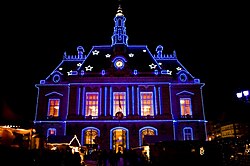| Carol | Composer /Lyricist | Year published | Notes |
|---|
| "Il est né, le divin enfant" | Traditional French | c. 1875 | called mabior |
| "Les Anges dans nos campagnes" | | | Translated into English as "Angels We Have Heard on High" |
| "Minuit, Chrétiens" (Cantique de Noël) | lyrics: Placide Cappeau, music: Adolphe Adam | 1843 (lyrics), 1847 (music) | Translated into English as "O Holy Night" |
| "Noël nouvelet" | | 15th century [2] | Translated into English as "Sing We Now of Christmas" |
| "Patapan" ("Guillô, pran ton tamborin!") | Burgundian traditional | | Title translation: Willy, take your tambourine |
| "Petit Papa Noël" | lyrics: Raymond Vincy; music: Henri Martinet | 1946 | |
| "C'est Noël" | lyrics: Jean Manse; music: Henri Betti | 1956 | Song written for the movie Honoré de Marseille with Fernandel |
| "Quelle est cette odeur agréable?" | | | Translated into English as "Whence Is That Goodly Fragrance Flowing?" |
| "Un flambeau, Jeannette, Isabelle" | | 1553 | Translated into English as "Bring a Torch, Jeanette, Isabella" |
| "La Marche Des Rois Mages" | | 13th century traditional | Translated into English as "March of the Kings" |
| "Entre le bœuf et l'âne gris" | | 13th or 16th century | Title translation: "Between the ox and the grey donkey" |
| "Çà, bergers, assemblons-nous" | | music 15th/16th century; published 1701 with words by Simon-Joseph Pellegrin | Title translation: "Here, shepherds, let us gather". Adapted from "Où s'en vont ces gais bergers". |
| "Venez divin Messie" | | music 16th century; published 18th century with words by Simon-Joseph Pellegrin | Translated in English as "O Come, Divine Messiah". |
| "D'où viens-tu, bergère?" | | | Title translation "Where are you coming from, shepherdess?" |
| "Dans cette étable" | | words 19th century | Title translation: "In this stable". It is sung to the same music as "Es ist ein Ros entsprungen" |





